Microneedling for Acne Scars
Acne scars can be distressing for many patients, forming when inflammation from pimples damages the surrounding skin tissue. Treating acne scars is often more challenging than treating acne itself, and most scars remain permanent without cosmetic intervention. A series of microneedling treatments can improve the appearance of acne scars. This procedure involves a device with tiny needles that penetrate the skin’s surface to stimulate the production of new collagen and elastin. These proteins contribute to youthful, smooth skin, and stimulating their production effectively “fills in” depressed acne scars. Microneedling is safe for all skin types and tones, effectively smoothing the skin’s surface and reducing the visibility of acne scars, with minimal downtime afterward.
Microneedling, also known as collagen induction therapy, is a non-invasive cosmetic treatment aimed at enhancing skin tone and texture. This procedure can address various skin concerns, including fine lines, enlarged pores, hyperpigmentation, stretch marks, and acne scars. Depressed acne scars are the most common type, occurring when there is insufficient new collagen production during the wound-healing process. Dermatology experts unanimously agree that microneedling is among the top non-invasive options for reducing the appearance of depressed post-acne scars. Furthermore, microneedling can be enhanced with different serums, such as platelet-rich plasma and depigmentation serum, to target specific skin issues more effectively. It stands as one of the most sought-after acne scar treatments at Dr. Michele Green’s private dermatology practice in NYC.
If you’re frustrated by the appearance of acne scars, board-certified dermatologist Dr. Michele Green in New York is here to assist you. Dr. Green is an internationally renowned expert in dermatology, boasting over two and a half decades of experience in treating active acne, reducing acne scars, and performing laser treatments, microneedling, and other non-invasive anti-aging procedures like Botox injections and dermal fillers. She adopts a holistic approach to facial rejuvenation, customizing each patient’s treatment plan to suit their needs and aesthetic goals best. Consistently recognized as one of the top dermatologists in NYC by Castle Connolly, Super Doctors, and New York Magazine for her dedication to patients and her expertise. Whether your skin issues include acne scarring, irregular texture, or hyperpigmentation, Dr. Green can help rejuvenate and enhance your complexion.
What is Microneedling treatment for acne scars?
Microneedling, also known as collagen induction therapy, is a non-invasive treatment aimed at reducing the appearance of acne scarring, fine lines, stretch marks, and various other skin concerns. Depressed acne scars occur due to a deficiency of collagen and tissue following an inflammatory acne lesion. Microneedling delivers controlled trauma to the skin’s surface by creating millions of tiny punctures with microneedles. These microneedles penetrate the skin’s epidermis and, in turn, trigger the skin’s natural healing process. This healing process stimulates the production of new collagen and elastin. Collagen and elastin are support proteins that provide structure and elasticity to the skin, playing crucial roles in maintaining a smooth, even complexion. Unlike invasive plastic surgery procedures, microneedling effectively rejuvenates the skin without discomfort or extensive recovery time. It is an innovative method for improving skin conditions across various skin types. It has been shown to actively increase collagen production in Fitzpatrick skin types I, III, and VI, according to a pivotal study published in the US National Institute of Health (NIH; J Clin Aesthet Dermatol. 2015 Jul; 8(7): 36–42).
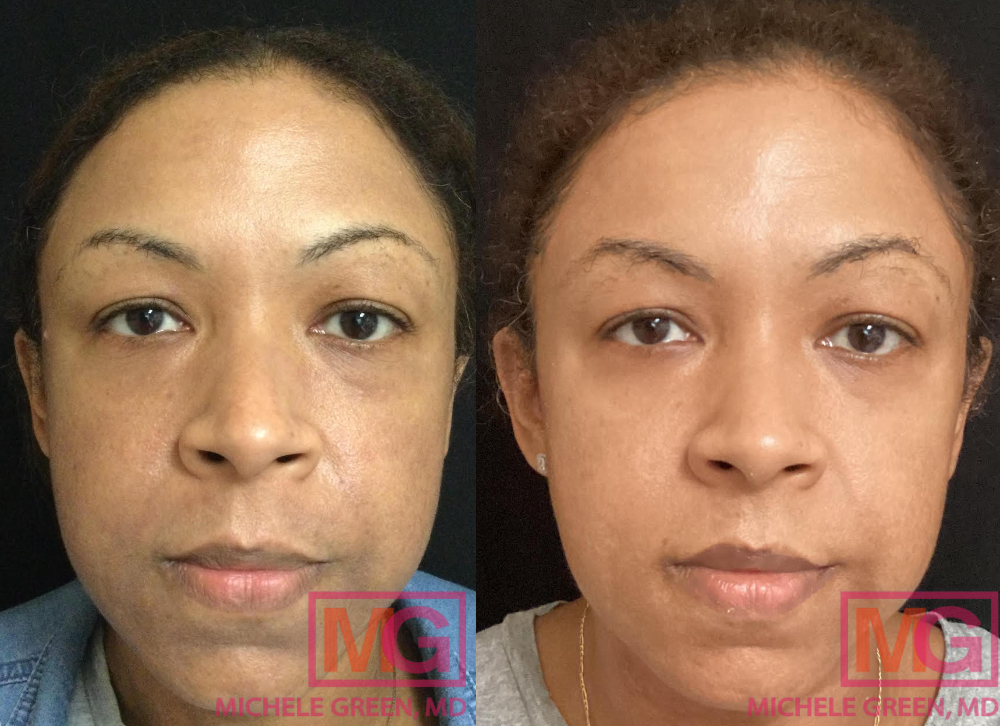
Microneedling before and after – 6 months
PRP Microneedling
Platelet-rich plasma (PRP) is an excellent complement to microneedling, enhancing and maximizing the procedure’s results. PRP is derived from a patient’s blood sample. The blood is collected and then spun in a centrifuge to isolate the nutrient-rich plasma, which contains natural growth factors and proteins that expedite skin healing, promote circulation, stimulate collagen growth, and accelerate skin regeneration. The PRP is applied topically to the skin and enters the microchannels created by the microneedling device, allowing for optimal absorption of the PRP and its enriching growth factors. By enhancing the microneedling procedure, PRP can induce greater collagen production and promote tissue regeneration, helping to reduce the appearance of and potentially erase acne scars. Since PRP comes from a patient’s blood sample, it is completely safe for all skin types and tones and essentially requires no downtime.
Microneedling with depigmenting serum for dark acne scars
Microneedling creates microchannels in the skin, making it an excellent option for enhancing the absorption of specialized serums. For patients with hyperpigmentation—whether in the form of melasma, sunspots, or pigmented acne scars—pairing microneedling with a depigmenting serum boosts collagen production and reduces hyperpigmentation. This depigmenting serum features a unique blend of effective yet gentle skin-brightening agents that inhibit melanocyte activity. Melanocytes produce melanin, which adds pigment to the skin. The result is an even-toned complexion with a noticeable reduction in hyperpigmentation. Patients appreciate that after microneedling with a depigmenting serum, their skin appears more radiant and has a lasting healthy glow. If you are dealing with the appearance of dark acne scars, melasma, sunspots, or post-inflammatory hyperpigmentation, consult Dr. Green about microneedling combined with a depigmenting serum.
Vivace RF Microneedling
Radiofrequency (RF) microneedling is a minimally invasive treatment that combines microneedling with radiofrequency energy to stimulate collagen production. The microneedling component promotes new collagen formation in the epidermis, while the radiofrequency energy simultaneously delivers heat to the dermis to encourage further collagen production. Like traditional microneedling, radiofrequency microneedling is a safe and effective skin rejuvenation treatment suitable for all skin types and tones, featuring minimal downtime and few potential side effects effects.
Dr. Green provides the Vivace radiofrequency microneedling treatment at her boutique dermatology office in NYC. Vivace delivers exceptionally precise, controlled pulses through gold-tipped, insulated microneedles. These features make the radiofrequency microneedling procedure painless for patients while enhancing collagen induction therapy. Vivace is an excellent treatment option for fine lines, enlarged pores, hyperpigmentation, acne scars, stretch marks, uneven skin tone, and improved skin elasticity. Most patients require multiple Vivace RF microneedling sessions, each spaced 4 to 6 weeks apart, to achieve optimal results.
What type of acne scars does microneedling help?
A common question in Dr. Green’s private dermatology office is, “What types of acne scars does microneedling help?” Microneedling is effective for depressed scars that resemble divots in the skin. Two main types of acne scars may develop after severe breakouts: atrophic scars and hypertrophic scars, with atrophic scars being more prevalent. These two types primarily differ in whether the damaged skin is raised or depressed. Hypertrophic scars present a raised appearance in the affected area due to excess collagen produced in response to damaged skin tissue. Hypertrophic acne scars, also known as keloids, tend to be significantly larger than the initial acne breakouts that caused them.
The second type of acne scarring, atrophic acne scars, results in a depressed appearance due to collagen loss or insufficient collagen production as the breakout resolves and the skin heals. Atrophic acne scars typically arise from severe acne, such as pustules or cystic acne, which are both inflamed and infected. When infected pus covers the skin, it can hinder proper healing. Microneedling is a treatment best suited for atrophic acne scars. Within the category of atrophic scars, three subtypes exist for more accurate description: icepick scars, boxcar scars, and rolling scars. During your consultation with Dr. Green regarding your acne scars, she will assess your skin and identify the types of scars present before creating a safe and effective treatment plan for you. Whether you have atrophic scars, hypertrophic scars, or post-inflammatory hyperpigmentation, Dr. Michele Green in New York City can assist you.
What is the process of microneedling treatment?
If you want to reduce acne scars, fine lines, or stretch marks, microneedling may be the ideal treatment for you. You will start with a consultation with Dr. Green, during which he will collect your complete medical history, including any prior cosmetic procedures. It’s essential to disclose if you have active acne breakouts, suffer from rosacea or eczema, or have other medical conditions. Then, the two of you will discuss the best treatment plan and your aesthetic goals. Microneedling can be performed on the same day or scheduled for a future appointment.
The microneedling procedure is quick and straightforward, taking about 15 minutes. A topical anesthetic will be sent to your pharmacy for you to apply at home one hour before the scheduled appointment. The numbing cream minimizes any potential discomfort during the procedure. After arriving at the office, the numbing cream will be removed, and the treatment area will be sterilized. Microneedling is performed using a small, handheld device with tiny needles that glide over the selected areas of your skin. These small pinpricks promote collagen production and enhance the appearance of your acne scarring. During and immediately after the microneedling, Dr. Green may apply a solution, such as platelet-rich plasma (PRP), to further stimulate the recovery process.
After your microneedling treatment, Dr. Green will advise you to refrain from cleansing your skin for 24 hours. This allows the topicals used during the treatment to be fully absorbed, enhancing both the healing process and the results of skin rejuvenation. You may find your skin feels dry or tight in the days following the treatment. To alleviate this dryness, Dr. Green often recommends that her patients use some of the ultra-nourishing skincare products from MGSKINLABs, Inc., such as Hydra Repair. Hydra Repair is specially formulated with a high concentration of hyaluronic acid, providing essential moisture during recovery. Dr. Green will also suggest which moisturizers and topical serums are best to use while healing, including a gentle cleanser and a broad-spectrum sunscreen with an SPF of 30 or higher. Wearing sunscreen is crucial, as the microneedling treatment increases your skin’s sensitivity to the sun. Patients are advised to stay away from exfoliating products such as retinols, alpha hydroxy acids, and beta hydroxy acids. When you have your microneedling session with Dr. Green, you will receive all the necessary aftercare to achieve and maintain optimal results.
What are the side effects of Microneedling?
Microneedling is a minimally invasive cosmetic procedure with very few side effects. Common side effects include mild erythema, dryness, flaking, and pinpoint bleeding, which typically resolve on their own within a few days after the treatment session. If microneedling is performed by an inexperienced or unqualified provider or conducted in a non-medical setting, more severe side effects can occur, such as hyperpigmentation, scarring, and skin discoloration. It is crucial to seek microneedling treatment from a board-certified dermatologist like Dr. Michele Green to avoid unwanted or adverse effects. Dr. Green has over twenty-five years of experience providing her patients with the most innovative cosmetic treatments, including traditional microneedling, PRP microneedling, and Radiofrequency Microneedling.
At-home skincare to use after microneedling sessions
Microneedling uses fine needles to create channels that enhance the absorption of skincare products after the procedure. One of the best products to pair with microneedling is hyaluronic acid, which can hold up to 1000 times its weight in water, attracting moisture to the skin for essential hydration. It also helps to plump the skin and temporarily smooth fine lines and wrinkles. In addition to hyaluronic acid, sunscreen is a vital part of the skincare routine following any microneedling treatment, as the treated area will be more sensitive to the sun. Sun exposure after microneedling can lead to hyperpigmentation and prolonged healing. For optimal protection, a broad-spectrum sunscreen with a minimum SPF of 50 is recommended. Skincare products that contain active exfoliating ingredients, such as retinoids and alpha hydroxy acids, should not be used for at least 3-5 days after microneedling. During your microneedling treatment with Dr. Green, she will provide you with all the essential aftercare needed to achieve and maintain optimal results, including the topical skincare products you should apply.
Why choose a dermatologist for your microneedling treatments?
Acne scars can be frustrating reminders of bothersome or painful breakouts and are often even more challenging to treat than the initial acne itself. When seeking treatment for acne scars, it is important to ensure that the procedures you undergo are the most effective for you and your skin, providing long-lasting cosmetic results. While some medical spas may offer microneedling performed by nurses or aestheticians, it is essential to verify the qualifications of your provider, as training is not always legally sufficient. Since microneedling involves delivering controlled trauma to the skin to stimulate collagen production, it is vital to conduct these procedures in a healthcare environment under completely sterile conditions. Additionally, the needles must penetrate the skin at precise depths to prevent unwanted side effects, such as infection or scarring. To achieve the best results in treating acne scars and minimize potential risks associated with certain methods, it is important to receive treatment from a medical professional who has the experience and expertise to carry out your procedures safely and effectively. Dr. Michele Green is an internationally recognized board-certified cosmetic dermatologist based in New York City, with over 25 years of experience treating discerning men and women worldwide for acne and acne scars. Dr. Green employs the latest techniques as a leader in the field of dermatology to provide you with the best cosmetic results.
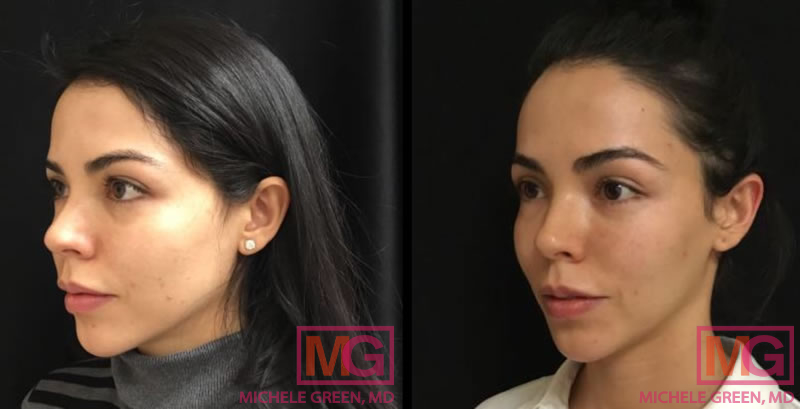
Before & After photo of patient with PRP, V-beam and Microneedling treatment
FAQs about microneedling for acne scars
Why is microneedling good for acne scars?
Microneedling devices feature tiny needles that create pinpricks in the top layer of the skin. When these microneedles puncture the skin, the controlled trauma induces the wound-healing response, which promotes new collagen production. Replenishing collagen in areas affected by acne scars reduces the damage from previous acne lesions, helping to rejuvenate skin texture. Most patients need a short series of microneedling treatment sessions to achieve optimal rejuvenation results, with each session spaced approximately four weeks apart. The microneedling treatment can also be enhanced by combining it with rejuvenating or restorative topical serums, as their absorbency is improved through the newly created microchannels in the skin. Depigmentation solutions are excellent options for reducing facial hyperpigmentation, as well as platelet-rich plasma treatment (PRP) for overall skin rejuvenation.
What size needle is needed for microneedling acne scars?
The microneedles used during the microneedling process vary in size, ranging from 0.25mm to 3mm in length. Typically, the microneedles measure between 1.5mm and 2mm in length when treating acne scars. The length of the microneedle may vary based on individual skin type, concerns, and the severity of acne scarring.
How many microneedling sessions do I need for acne scars?
The number of microneedling sessions required to reduce acne scars varies depending on the size and severity of the scars being treated. To fully rejuvenate the skin’s surface, this procedure typically necessitates several sessions. Most patients require a short series of 3 to 6 microneedling treatments to achieve optimal results. Each session should be scheduled approximately four weeks apart. Additionally, many patients receive regular maintenance treatments every quarter to sustain the skin rejuvenation effects of microneedling. During your consultation with board-certified dermatologist Dr. Green at her private office in NYC, she will work with you to develop a personalized treatment plan and timeline for your microneedling sessions that will yield the best results.
How long does microneedling take to get rid of acne scars?
After the microneedling treatment, you may begin to notice some improvements immediately; however, collagen production and the healing process primarily occur gradually. You will see further improvements in the weeks following the microneedling sessions and even more after each follow-up treatment. It takes time for collagen to develop, and the full results are typically visible six months after the microneedling sessions. Dr. Green recommends at least three microneedling sessions spaced one month apart, with maintenance sessions scheduled every six months for optimal cosmetic results. Additional treatments may be necessary for more severe acne scars and can be combined with other cosmetic procedures like chemical peels, dermal fillers, or laser rejuvenation. After microneedling treatments, your acne scars will not reappear. As part of the natural aging process, you may lose some volume over time, making residual acne scars more noticeable. However, your microneedling treatments will ultimately improve your skin’s smoothness. When consulting with Dr. Green about your acne scar treatment, she will develop a treatment plan and discuss the expected timeline with you to ensure you achieve smooth, even skin.
Will microneedling get rid of scars?
While the skin rejuvenation benefits of microneedling can be long-lasting, they are not always permanent. Microneedling often leads to lasting improvements for skin concerns such as acne scars. However, since the skin is a living tissue, it is naturally susceptible to aging. As we age and collagen continues to break down, skin issues treated with microneedling may become more noticeable again. Most patients who undergo traditional PRP or radiofrequency microneedling establish a schedule for regular maintenance sessions to achieve optimal results. Dr. Green may recommend that patients with severe acne scars consider skin resurfacing laser treatments or dermal filler injections instead of, or in addition to, microneedling therapy. Regardless of the severity of your acne scars, Dr. Green in NYC offers non-invasive cosmetic solutions that provide stunning, natural-looking, long-lasting results.
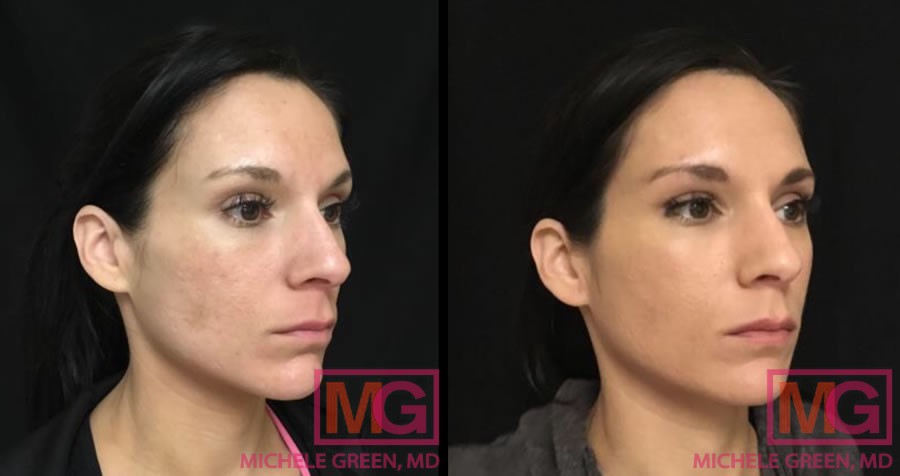
Does microneedling really work on acne scars?
Yes! Suppose you’re uncertain about how microneedling treatments work for acne scars. In that case, you can be assured that microneedling is an effective and clinically proven method that significantly reduces the appearance of acne scarring. Microneedling is an FDA-approved treatment for acne scars, which indicates it is recognized as safe and effective. In a study conducted by the NIH, patients who underwent five microneedling sessions for moderate acne scars experienced improvements in skin health and noticeable scar reduction, and, in some cases, there was almost complete disappearance of acne scarring.
Which microneedling is best for acne scars?
Microneedling can be enhanced with additional serums, such as platelet-rich plasma and depigmentation serum, or combined with radiofrequency energy, as seen in the Vivace treatment. Choosing the best microneedling option for your acne scars can be challenging. Patients with dark acne scars may benefit from depigmentation serum, which helps improve both skin tone and texture. Conversely, RF microneedling can promote increased collagen production by heating the dermis, offering significant advantages for those with texture issues. Microneedling with PRP utilizes growth factors in the blood to accelerate wound healing and reduce recovery time. Therefore, it is advisable to consult with a board-certified dermatologist, such as Dr. Michele Green in New York City. During your consultation, Dr. Green will assess your acne scars and develop a personalized treatment plan designed to effectively reduce your acne scars, helping you achieve smooth, clear skin.
Should you have Microneedling if you still have active acne?
No! You should not undergo microneedling if you still have active acne. Microneedling over active acne lesions can contaminate the microneedles with acne-causing bacteria. As the microneedles are passed across the face, the bacteria spread, worsening the breakout. The active acne should be treated first before undergoing the procedure to minimize the risk of infection spreading. Additionally, addressing pimples and active acne as soon as possible will help prevent the formation of new acne scars on the skin. A board-certified dermatologist, such as Dr. Michele Green, can assist you with various topical or oral medications to treat your acne breakouts. Once the breakouts are managed, Dr. Green can perform the microneedling procedure to correct the acne scars as well as other skin concerns, resulting in a smooth, youthful appearance.
Will acne scars come back after microneedling?
Many patients at Dr. Green’s office ask, “Does microneedling remove scars permanently?” The answer is that acne scars will not return after microneedling. Microneedling promotes collagen production, smoothing skin texture and diminishing the appearance of atrophic acne scars. The results from the procedure are permanent and will not reverse. While new acne scars can form if you experience severe acne breakouts, these new scars will not be the same as those that were treated. Microneedling allows the body’s natural healing processes to take control, breaking up damaged skin caused by acne scarring and restoring elasticity and volume. Most patients see significant improvements in the appearance of their acne scars, resulting in a lasting enhancement in the look and feel of their skin.
How much does Microneedling for acne scars cost?
The total cost of your microneedling treatment depends on several varying factors. Your geographic location and the experience level of your healthcare provider are two key aspects influencing the overall cost of microneedling. While it is usually less expensive to have microneedling performed by an aesthetician in a medical spa setting, they may lack the qualifications to safely and legally perform the procedure. In New York, only a licensed acupuncturist, board-certified dermatologist, or plastic surgeon is authorized to carry out microneedling. It is always advisable to seek microneedling treatment from an experienced board-certified dermatologist like Dr. Green to ensure safety, efficacy, and optimal results.
Furthermore, any enhancements, such as depigmentation serum, platelet-rich plasma, or radiofrequency added to the microneedling procedure, will increase the overall cost. During your consultation with board-certified dermatologist Dr. Michele Green at her private office in NYC, you’ll have the opportunity to discuss your skin concerns and aesthetic goals. Dr. Green will examine your skin condition and recommend a microneedling treatment plan for rejuvenation. Pricing will be reviewed prior to any treatments taking place.
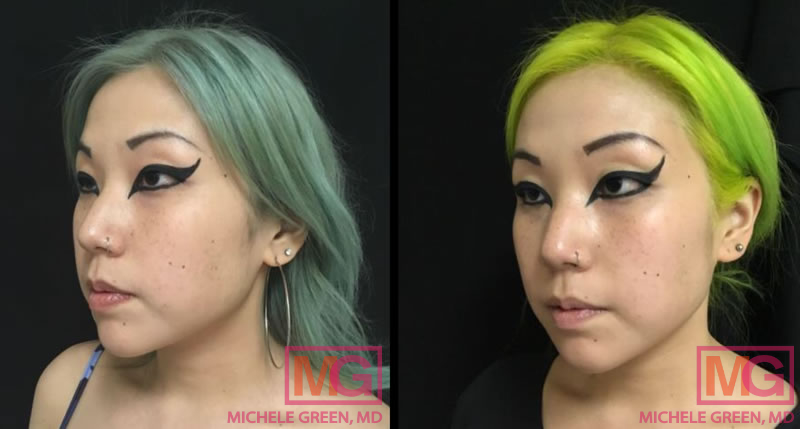
What are some of the different treatments for acne scars?
Many patients in Dr. Green’s office ask, “Which treatment is best to treat acne scars?” The answer is that often, multiple treatment modalities must be used together to achieve the best results. In addition to microneedling, acne scars can also be treated with lasers, subcision with dermal fillers, and chemical peels.
Laser Treatments
The Fraxel laser is a fractionated skin resurfacing treatment that stimulates new collagen production in the dermal layer of the skin. Dr. Green utilizes the 1550nm wavelength setting, among its two different wavelength options, to enhance skin texture and diminish the appearance of acne scars. As a non-ablative and fractionated laser treatment, Fraxel forms microscopic laser columns that penetrate deep into the skin, preserving the top layer and leaving the surrounding area untouched. Downtime is minimal, with patients typically experiencing redness and mild swelling that subside within 48 hours after treatment. Generally, five Fraxel laser sessions are necessary to address acne scars, with each session spaced approximately one month apart.
The eMatrix laser is a resurfacing treatment that employs radiofrequency energy to stimulate collagen production, smoothing the skin and reducing the appearance of acne scars. This laser offers safe and effective treatment for individuals of all skin tones, making it an excellent choice for patients with darker skin tones who are prone to hyperpigmentation. The heat energy from the laser penetrates the deeper layers of the dermis while leaving the top layer of skin unharmed, which minimizes the risk of scarring and hyperpigmentation, resulting in minimal downtime – the healing process typically takes 48 hours, during which patients may experience mild facial redness and swelling. The eMatrix laser is most effective for atrophic acne scars, and generally, five treatment sessions spaced 4 to 6 weeks apart are recommended for optimal results.
The VBeam laser has long been regarded as the gold standard for reducing the appearance of redness and red acne scars. It employs pulsed dye technology to deliver a precise wavelength of light that targets red pigment while leaving the surrounding skin unaffected. In addition to addressing red pigmentation, the V-Beam laser also heats the deeper layers of the skin to stimulate new collagen production, resulting in a smoother skin texture and improved clarity. There is no downtime, redness, or swelling associated with V-Beam laser treatment. Most patients require 5 to 6 treatment sessions to achieve optimal rejuvenation results and minimize post-inflammatory hyperpigmentation.
Subcision with dermal fillers
Subcision with dermal fillers effectively treats depressed acne scars by breaking up scar tissue and restoring lost volume to the area. During the subcision procedure, a needle is utilized to disrupt the scar tissue that pulls the skin downward, forming the depressed acne scar. When subcision is performed with dermal fillers, the filler is injected directly into the scar to replace lost volume and provide a smoother skin surface almost immediately. Dr. Green often performs subcision using Sculptra or hyaluronic acid dermal fillers to achieve optimal cosmetic results with no downtime. Dr. Green’s unique technique of subcision and injection improves the appearance of scars even after just one treatment, depending on the type and severity of the acne scars.
Sculptra is a distinctive dermal filler because it contains a substance called poly-L-lactic acid, which stimulates collagen production. As collagen develops over time, the skin texture improves, reducing the visibility of depressed acne scars. Most patients require a brief series of three Sculptra treatment sessions to attain optimal results. It takes about 4 to 6 weeks to notice the effects of each Sculptra treatment, and results can last up to two years. Most patients participate in regular follow-up sessions to maintain ideal outcomes. Dermal fillers like Juvederm and Restylane contain hyaluronic acid, a naturally occurring substance in the skin that supports hydration and a youthful appearance. These fillers are commonly utilized to restore lost volume due to acne scars, promoting a smoother appearance. Results with hyaluronic acid fillers are immediate and can last anywhere from six to twelve months.
Chemical peels are resurfacing treatments that use chemo-exfoliation to accelerate skin cell turnover and stimulate new collagen production, thereby enhancing overall skin tone and texture. Various types of chemical peels can effectively treat acne scars, with each type using a unique acid-based ingredient to exfoliate the skin’s surface. Chemical peels are classified as superficial (or light), medium depth, and deep. Generally, the most effective superficial chemical peels for acne include glycolic acid or light trichloroacetic acid (TCA). Medium-depth peels typically contain an acid solution with 20% trichloroacetic acid (TCA) or more. A series of three to six chemical peels is usually recommended to treat acne scars, depending on the severity of the scars and hyperpigmentation.
Mesopeels are specially formulated chemical peels that are excellent for improving post-inflammatory hyperpigmentation caused by acne scars. They utilize chemo-exfoliation to boost collagen production, removing dead, pigmented cells to reveal new, healthy, even-toned cells at the skin’s surface. Mesopeels involve no downtime and are a safe, effective method for achieving an even-toned, radiant complexion. It is often recommended to undergo a series of three to six Mesopeels to treat hyperpigmentation resulting from acne scars.
What is better for acne scars, laser or microneedling?
Many patients want to know, “Which is better for acne scars: microneedling or laser?” The answer is that it depends. Often, the most effective treatment for acne scars is a unique combination of different approaches, including lasers, microneedling, and subcision with dermal fillers. Both microneedling and laser treatments can effectively address acne scars. Microneedling is excellent for inducing collagen production and can be combined with various serums and radiofrequency to enhance its ability to improve skin tone and texture. Lasers can also stimulate collagen production and correct skin tone and texture through different modalities. For example, while microneedling creates microinjuries to promote collagen production through the wound healing process, the Fraxel laser uses light energy to heat the dermis of the skin, encouraging collagen production. Additionally, the V-Beam laser can improve the appearance of red acne scars. When you consult with Dr. Green about your acne scars, she will identify the best treatment plan for you, incorporating microneedling, lasers, or a combination of both treatments.
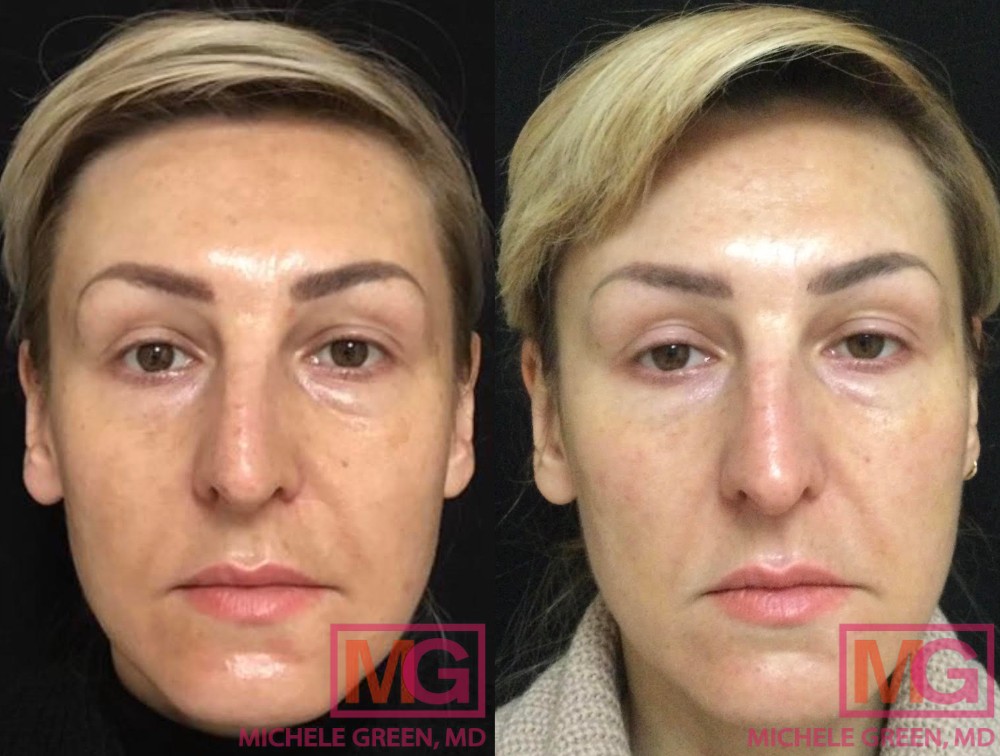
What is better for acne scars, Microdermabrasion or Microneedling?
Initially, microneedling and microdermabrasion may seem similar to cosmetic treatments, but they are actually quite distinct procedures. Microdermabrasion involves applying exfoliating crystals to the skin, effectively removing the surface layers of dead, dull, and discolored skin cells. This process results in a smoother, brighter, and clearer complexion without the need for downtime. In contrast, microneedling uses ultra-fine needles to penetrate deeper into the epidermis, triggering the skin’s natural wound-healing response by creating controlled injuries. This process leads to the production of new collagen and elastin. Microneedling is effective for treating acne scars, textural irregularities, enlarged pores, fine lines and wrinkles, uneven skin tone, dullness, and more.
Microneedling can be enhanced with additional serums and radiofrequency energy to improve treatment outcomes. Depending on the severity of a patient’s acne scars and their ultimate cosmetic goals, either microdermabrasion or microneedling may be suitable options. The best way to determine which non-invasive cosmetic treatment is more appropriate for your specific acne scars is to consult board-certified cosmetic dermatologist Dr. Michele Green. Dr. Green has extensive experience treating all forms of acne scars with the latest advanced techniques. For patients with acne scars of any skin tone and type, Dr. Green will develop a customized treatment plan designed to yield optimal results.
Dermarolling for treating acne scars
You may have also heard of the skin needling treatment called derma rolling, sometimes referred to as home microneedling. Dermarolling involves using a hand-held roller with many small needles that you roll across the skin of your face in horizontal, vertical, and diagonal motions. Although a derma roller is intended to create the same slight trauma to your skin as Microneedling at a dermatologist’s office, it is crucial to use it correctly to avoid damaging your facial skin. Moreover, since Microneedling is not suitable for all types of acne scars, using a derma roller at home without consulting a dermatologist may lead to skin damage. It is essential to consult with a board-certified dermatologist, such as Dr. Green, to receive the highest quality, permanent treatment tailored to your needs needs.
Can you microneedle with active acne?
No, microneedling is not recommended for patients with active acne. Acne blemishes harbor bacteria, and performing microneedling on active acne can contaminate the microneedles with acne-causing bacteria, potentially spreading infection and worsening the breakout. Patients with active acne interested in microneedling to address other skin concerns—such as fine lines, wrinkles, enlarged pores, or hyperpigmentation—should manage their acne breakouts before undergoing the microneedling procedure. Treating acne early is crucial to prevent the formation of scars. Consulting with a qualified, board-certified dermatologist, such as Dr. Green in New York City, is the best way to safely, effectively, and quickly treat breakouts. Once the breakouts are under control, microneedling can be performed to address other skin issues and enhance skin rejuvenation.
Which serum is best for microneedling acne scars?
A key aspect of microneedling is its ability to create microchannels on the skin’s surface, enhancing the absorption of topical skincare products. Utilizing suitable serums during and after a microneedling procedure can treat various skin concerns more effectively. The ideal serum will vary for each patient based on their specific skin issue. For instance, those with dark acne scars might find a depigmentation serum particularly beneficial during the procedure, as it penetrates deeper into the skin to reduce hyperpigmentation. In traditional microneedling, hyaluronic acid is applied to boost hydration. This potent humectant delivers essential moisture to the skin. Dr. Green’s Hydra Repair from her MGSKINLABs skincare line is carefully formulated with a high concentration of hyaluronic acid to restore critical moisture to the skin during the recovery process. When consulting with Dr. Green about your microneedling treatment, you will have the opportunity to explore various serums and identify which one is best suited for you.
What is the process of microneedling for acne scars?
Microneedling is a cosmetic procedure that should be carried out exclusively by a trained healthcare professional, such as a board-certified dermatologist. If you have unwanted acne scars, an experienced board-certified dermatologist like Dr. Michele Green can effectively address them. Microneedling for acne scars is a quick and straightforward process. To receive your microneedling treatment, you must first consult with Dr. Michele Green at her private dermatology office in the Upper East Side of Manhattan. She will evaluate your medical history, past cosmetic treatments, and specific skin care concerns and aesthetic goals before formulating a personalized treatment plan that may involve a combination of therapies aimed at minimizing your acne scars for smooth, clear skin.
Why do my acne scars look worse after Microneedling?
Some patients may notice a temporary worsening of their acne scars immediately following the microneedling procedure. Microneedling stimulates the wound-healing response by creating millions of microchannels in the skin. These micro-injuries can lead to irritation and inflammation in some patients. Inflammation may manifest as increased redness and more noticeable skin texture issues. Fortunately, this temporary worsening is expected to resolve on its own within a few days after the procedure treatment.
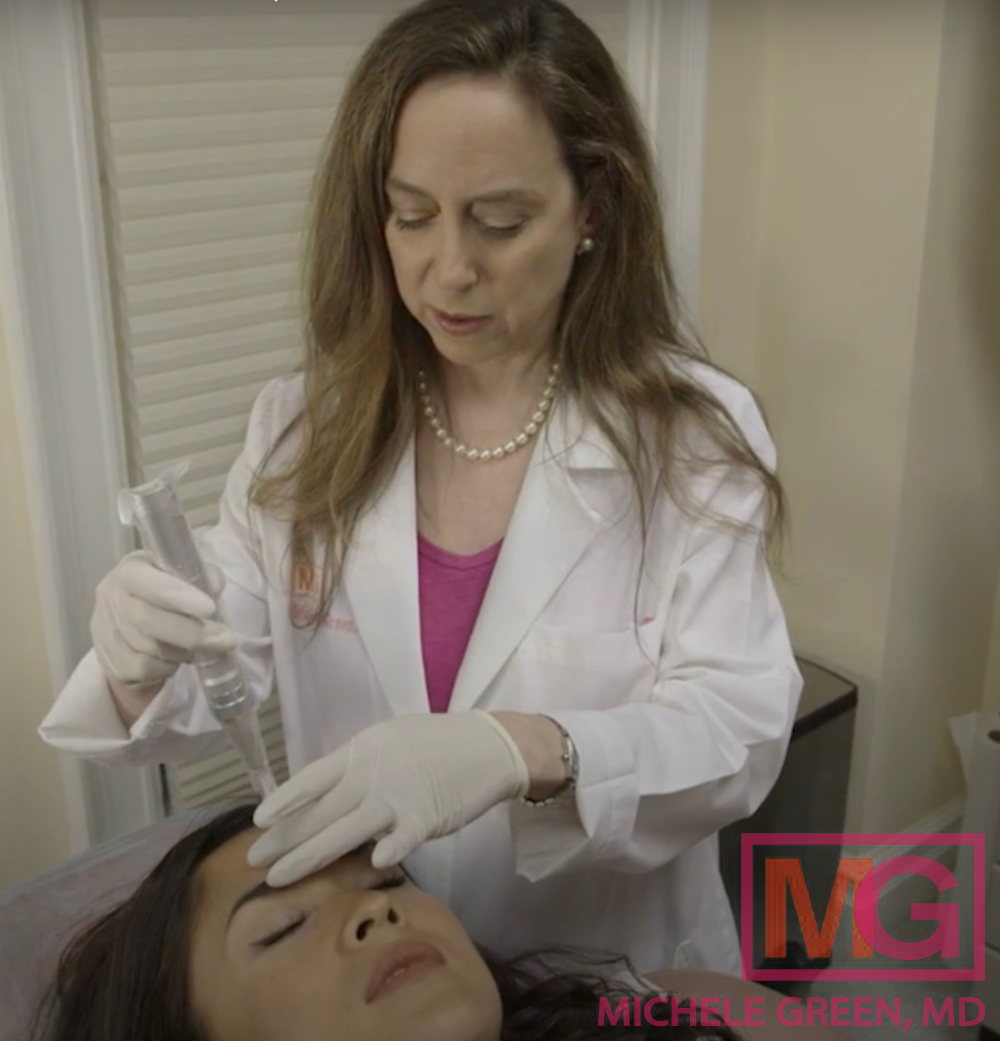
How to get started with Microneedling for acne scars today?
Acne scars can be challenging to treat, and for many, they may induce feelings of self-consciousness or low self-esteem. Luckily, non-invasive treatments such as microneedling, also known as collagen induction therapy, can help reduce the appearance of atrophic acne scars. Microneedling can address various skin concerns, including fine lines, enlarged pores, hyperpigmentation, stretch marks, and acne scars. It’s estimated that one in every five individuals experiencing breakouts will develop acne scarring. If you’re frustrated by the look of acne or acne scarring, Dr. Green is here to help. Whether the best treatment for your acne scars is microneedling, lasers, chemical peels, dermal fillers, or other cosmetic procedures, Dr. Green offers cutting-edge acne scar treatments and will tailor your treatment plan to meet your needs and achieve your cosmetic goals.
Dr. Michele Green is an internationally renowned board-certified cosmetic dermatologist with over 25 years of experience providing discerning individuals with the best non-invasive cosmetic treatment options, including microneedling for acne scars. She is consistently recognized as one of New York’s best dermatologists by Castle Connolly, Super Doctors, New York Magazine, and the New York Times for her dedication to her patients and expertise. When you consult with Dr. Green at her private dermatology office in Manhattan’s Upper East Side, she will work closely with you to create a customized rejuvenation treatment plan that best addresses your unique skin concerns and achieves optimal cosmetic results. To get started on your personalized acne scar treatment plan and learn more about microneedling, schedule a consultation with Dr. Green by calling the NYC office at 212-535-3088 or contacting us online.
 212-535-3088
212-535-3088